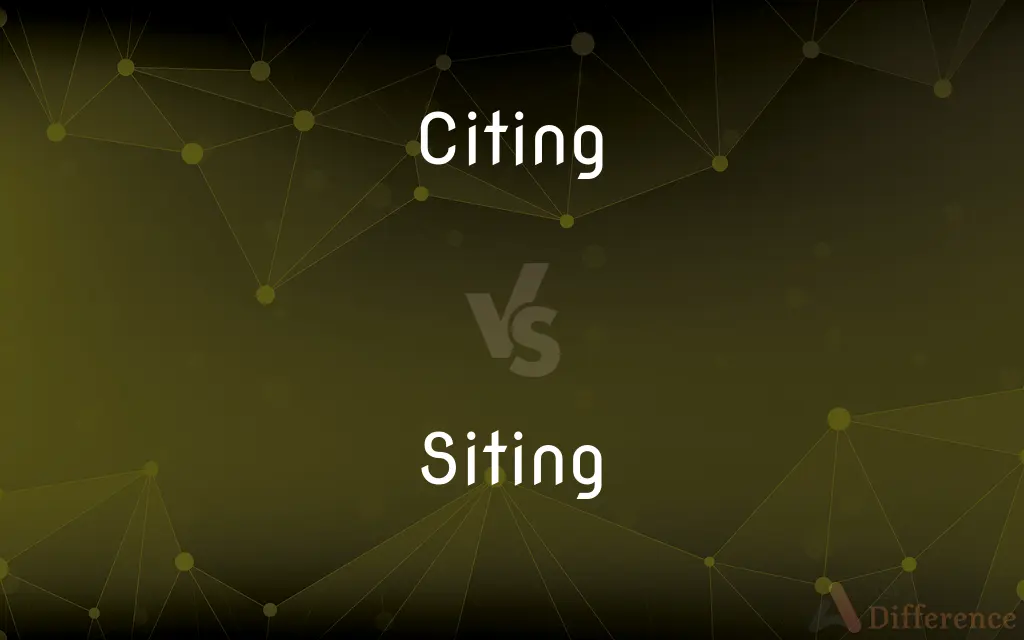Citing vs. Siting — What's the Difference?
Edited by Tayyaba Rehman — By Urooj Arif — Updated on April 8, 2024
Citing involves referencing sources, while siting refers to choosing a location.

Difference Between Citing and Siting
Table of Contents
ADVERTISEMENT
Key Differences
Citing is an academic or professional practice that involves acknowledging the use of someone else’s ideas, work, or data within your own work to support your arguments or findings. This is a critical aspect of writing in many fields, ensuring intellectual honesty and allowing readers to trace the origins of ideas. On the other hand, siting is a term commonly used in planning and construction that pertains to the selection of a location for a particular purpose, such as building a facility, installing equipment, or setting up a project. The process involves evaluating various factors like environmental impact, accessibility, regulatory compliance, and cost-effectiveness.
While citing is governed by specific style guides and ethical standards, such as APA, MLA, or Chicago style, which dictate how references should be formatted and presented, siting decisions are influenced by practical considerations, legal requirements, and strategic objectives. Citing sources enhances the credibility and integrity of a piece of work by providing evidence and avoiding plagiarism. Conversely, effective siting is crucial for the feasibility, sustainability, and success of projects, impacting their operational efficiency and integration with the surrounding environment.
Citing and siting, though phonetically similar, serve entirely different purposes in academic and professional contexts. The former is a cornerstone of scholarly communication, promoting transparency and academic integrity, while the latter is a key component of planning and development, ensuring that projects are appropriately located to meet their intended goals and comply with relevant standards and regulations.
Mastering the practice of citing is essential for students, researchers, and professionals who contribute to the body of academic knowledge, requiring an understanding of various citation formats and the ethical considerations of using others' work. In contrast, expertise in siting is vital for planners, engineers, architects, and developers, who must navigate complex evaluations involving geographical, environmental, social, and economic factors.
Comparison Chart
Definition
Acknowledging the use of others' ideas or data.
Selecting a location for a project or facility.
ADVERTISEMENT
Purpose
To support arguments and avoid plagiarism.
To ensure the project's success and compliance.
Guided by
Style guides (APA, MLA, Chicago) and ethics.
Practical considerations, laws, and strategic objectives.
Importance
Enhances credibility and integrity of work.
Impacts operational efficiency and environmental integration.
Professional Use
Critical in academic writing and research.
Essential in planning, construction, and development.
Compare with Definitions
Citing
Acknowledging the origin of ideas or data.
Citing seminal works is crucial in literature reviews.
Siting
Considering environmental and legal aspects in location selection.
Siting a chemical plant involves stringent environmental reviews.
Citing
Making reference to another's work to support your argument.
Researchers must follow specific formats when citing sources in their papers.
Siting
Evaluating factors for the best location.
Siting wind turbines requires analysis of wind patterns and environmental impacts.
Citing
Enhancing the credibility of scholarly work.
Scholarly work gains more respect and trustworthiness by citing authoritative sources.
Siting
Ensuring strategic alignment with goals and regulations.
The siting decision was influenced by local zoning laws and community feedback.
Citing
Providing evidence for claims made.
Accurate citing helps in constructing a robust argumentation framework.
Siting
Choosing a location for building something.
The committee is in the process of siting the new library.
Citing
Avoiding plagiarism through proper attribution.
Citing all sources correctly is the best defense against plagiarism accusations.
Siting
Planning the placement of projects or facilities.
Effective siting is crucial for minimizing construction costs and maximizing efficiency.
Citing
Present participle of cite
Siting
The action of locating something in a particular place
Decisions concerning the siting of nuclear power plants
Citing
Citation.
Siting
The place where a structure or group of structures was, is, or is to be located
A good site for the school.
Siting
The place or setting of something
A historic site.
A job site.
Siting
A website.
Siting
To situate or locate on a site
Sited the power plant by the river.
Siting
Present participle of site
Siting
Misspelling of citing
Siting
Misspelling of sitting
Siting
The act of finding a site for something.
Common Curiosities
What are the consequences of failing to properly cite sources?
Failure to properly cite sources can result in accusations of plagiarism, loss of credibility, and potential legal and academic sanctions.
What is the difference between a bibliography and citing?
Citing refers to the act of referencing within the text, while a bibliography is a list of all the sources referenced in the work.
Can the siting of a project change once it has begun?
Yes, project siting can change due to unforeseen circumstances, but this may involve additional costs, delays, and regulatory approvals.
Is citing only necessary in academic writing?
While most associated with academic writing, citing is also crucial in professional documents and reports to support claims and acknowledge sources.
How do environmental considerations impact siting decisions?
Environmental considerations are key in siting decisions, affecting where and how projects are developed to minimize ecological disruption and meet sustainability goals.
Why is siting important?
Siting is important for the success and sustainability of projects, ensuring they are located in places that meet operational, environmental, and regulatory requirements.
Are there tools to assist with citing?
Yes, there are numerous citation generators and management tools available that can assist in properly formatting and organizing citations.
What role does community feedback play in siting decisions?
Community feedback can significantly influence siting decisions, especially in projects requiring public support or affecting local environments and economies.
What are some challenges in siting renewable energy projects?
Challenges include finding locations with optimal resource availability, navigating regulatory hurdles, and addressing local community concerns.
What does citing involve?
Citing involves acknowledging and referencing the work of others within your own work to support your arguments and maintain academic integrity.
What factors influence siting decisions?
Siting decisions are influenced by geographical, environmental, legal, social, and economic factors, as well as project-specific requirements.
How do I know which citation style to use?
The choice of citation style often depends on the discipline, publication, or institutional requirements.
Can the incorrect use of citing or siting affect my work?
Yes, incorrect usage can lead to misunderstandings in academic or professional contexts, affecting the clarity and credibility of your work.
How do I choose between citing and siting in writing?
Choose "citing" when referring to the act of referencing sources in academic or professional work, and "siting" when discussing the selection of a location for a project.
How do citing practices vary internationally?
While the principles of citing are universally recognized, specific practices and preferred citation styles can vary by country and academic community.
Share Your Discovery

Previous Comparison
Cero vs. Zero
Next Comparison
Speed vs. FastAuthor Spotlight
Written by
Urooj ArifUrooj is a skilled content writer at Ask Difference, known for her exceptional ability to simplify complex topics into engaging and informative content. With a passion for research and a flair for clear, concise writing, she consistently delivers articles that resonate with our diverse audience.
Edited by
Tayyaba RehmanTayyaba Rehman is a distinguished writer, currently serving as a primary contributor to askdifference.com. As a researcher in semantics and etymology, Tayyaba's passion for the complexity of languages and their distinctions has found a perfect home on the platform. Tayyaba delves into the intricacies of language, distinguishing between commonly confused words and phrases, thereby providing clarity for readers worldwide.
















































